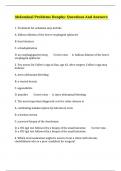Introduction to Privacy Online (Walther, 2011)
There is a tension between users’ desires to communicate online in very personal ways and
their assumptions that their disclosures will be treated as privileged and private.
à The more users disclose of themselves, the more they may enjoy the benefits the systems
have to offer. At the same time, the more they disclose, the more they risk what they consider
disclosure of their privacy.
There are 3 complicating factors that confront users of online systems
1) A misplaced presumption that online behavior is private
2) The nature of the Internet is quite incommensurate with privacy
3) One’s expectation of privacy does not constitute privileged communication by
definition
There is a psychological privacy with new media, not informational privacy. People think
what they share is private. However, if anyone in the Internet-using public can see one’s
messages, the messages are in the public domain. People are not aware enough that their
messages, phone calls, etc. are not private and are not protected by legal laws.
There is a change in technological efforts for the protection of privacy; social media
offers adolescents online communication that is vital to their development, especially that
which may be done anonymously, pseudonymously, or confidentially allows for the
exploration of identity generally and for the examination of sexual identity. The same for
asking and receiving advice on deeply personal issues on discussion systems.
Users keep actively managing their online self-presentations even when there is a lot
of personal information out in the open (e.g., name, pictures).
1
,Self-Disclosure in social media: Extending the Functional Approach to Disclosure
Motivations and Characteristics on Social Network Sites (Bazarova & Choi, 2014)
Disclosure fulfills fundamental needs for social connectedness and belonging and is
intrinsically rewarding, but it also carries inherent risks of vulnerability and information loss
because a discloser gives up some degree of privacy and personal control by sharing
information with others.
à balance of conflicting needs.
A common strategy for optimizing the disclosure rewards–risks ratio is to establish a dyadic
boundary within which a discloser shares personal information with a trusted recipient – it
minimizes a discloser’s vulnerability and personal information risks, while still satisfying the
desired goals and motivations. This can also happen with a stranger that has no access to the
discloser’s social circle.
à people are most comfortable sharing intimate disclosures with either a complete stranger or
a trusted companion within a dyadic boundary.
The least disclosure occurs between acquaintances who do not know each other well
but anticipate future interaction, and in the presence of uninvolved third parties due to
increased vulnerability and information control losses.
Social network site (SNS) users broadcast personal (and intimate) information to an entire
network.
à this is incongruent to the principle of incremental disclosure that suggests that people start
by sharing peripheral information and move to more intimate disclosures as they gain trust in
their partner.
Disclosure goals activate disclosure decision-making process and shape its content. The
sources of value for self-disclosure (social rewards) must be discovered. There are 5
categories:
1) Social validation, validate one’s self-concept and self-value by increasing social
approval and liking.
2) Self-expression, relieve distress through venting out negative emotions and disclosing
problems.
3) Relational development, increase relational intimacy and closeness.
4) Identity clarification, conveys information about one’s identity and defines one’s
position for self and others.
5) Social control, share certain information about self to control social outcomes.
Hypotheses
Personality traits and situational cues activate disclosure goals and rewards. Visibility of
information and directedness of interaction affect disclosure motivation due to their role in
constructing audience representations on SNSs.
People don’t know their audience exactly online; they only have an imagined audience. The
representation of a specific audience vs. general others triggers different disclosure goals.
2
, n H1: people pursue different disclosure goals in Facebook status updates, wall posts,
and private messages. TRUE
n H2: disclosures directed at a familiar other (via private messages) are associated with
relational development goals more than disclosures directed at general others, as via
Facebook status updates. TRUE
n H3a: people pursue greater social validation goals in nondirected status updates
compared to directed wall posts and private messages. TRUE
n H3b: social validation goals are more salient in public wall posts compared to private
messages because of wall posts’ visibility. TRUE
Expectations of intimacy and norms are likely to guide people to be less private and intimate
in public than in private Facebook communication. People will disclose more information
when this is done in private since they know their target audience, so people may compensate
for the lack of target control by increased information control and selectivity.
n H4: SNS users can adapt to different affordances by choosing to reveal less intimate
and private information via public status updates and wall posts than via private
messaging on Facebook. TRUE
n H5: disclosure goals are expected to affect disclosure intimacy. TRUE
n H6: less intimate disclosure is associated with social validation goals compared to
other self-disclosure goals, especially the more personally involving relational
development goals. TRUE
n H7: disclosure goals are predicted to mediate between Facebook communication
forms and disclosure intimacy. TRUE
3
, The Role of Privacy Fatigue in Online Privacy Behavior (Choi, Park & Jung, 2018)
Privacy fatigue reflects a sense of weariness toward privacy issues, people get lazy and reduce
their decision-making efforts, they agree with the privacy settings. People underestimate or
ignore the risk. However, they do not want their personal information to be misused.
SNS fatigue: negative affective responses to SNS activities.
H1a: a higher level of privacy concern will result in less intention to disclose personal
information. TRUE
H1b: a higher level of privacy concern will result in less disengagement. TRUE
à privacy concern has a significant impact on the intention of privacy protection.
H2a: a higher level of privacy fatigue will result in higher intention to provide personal
information. TRUE
H2b: a higher level of privacy fatigue will result in higher disengagement. TRUE
4







